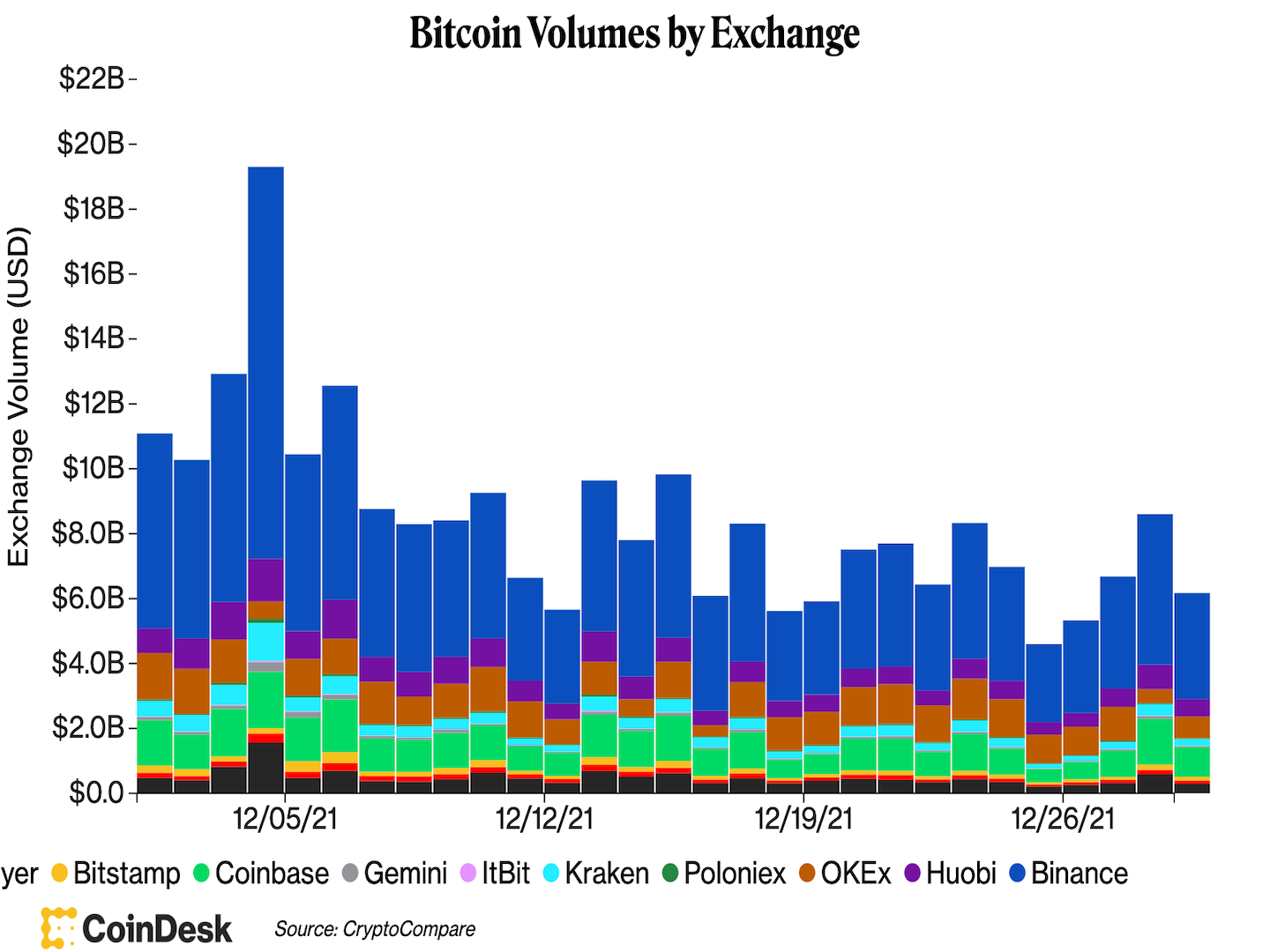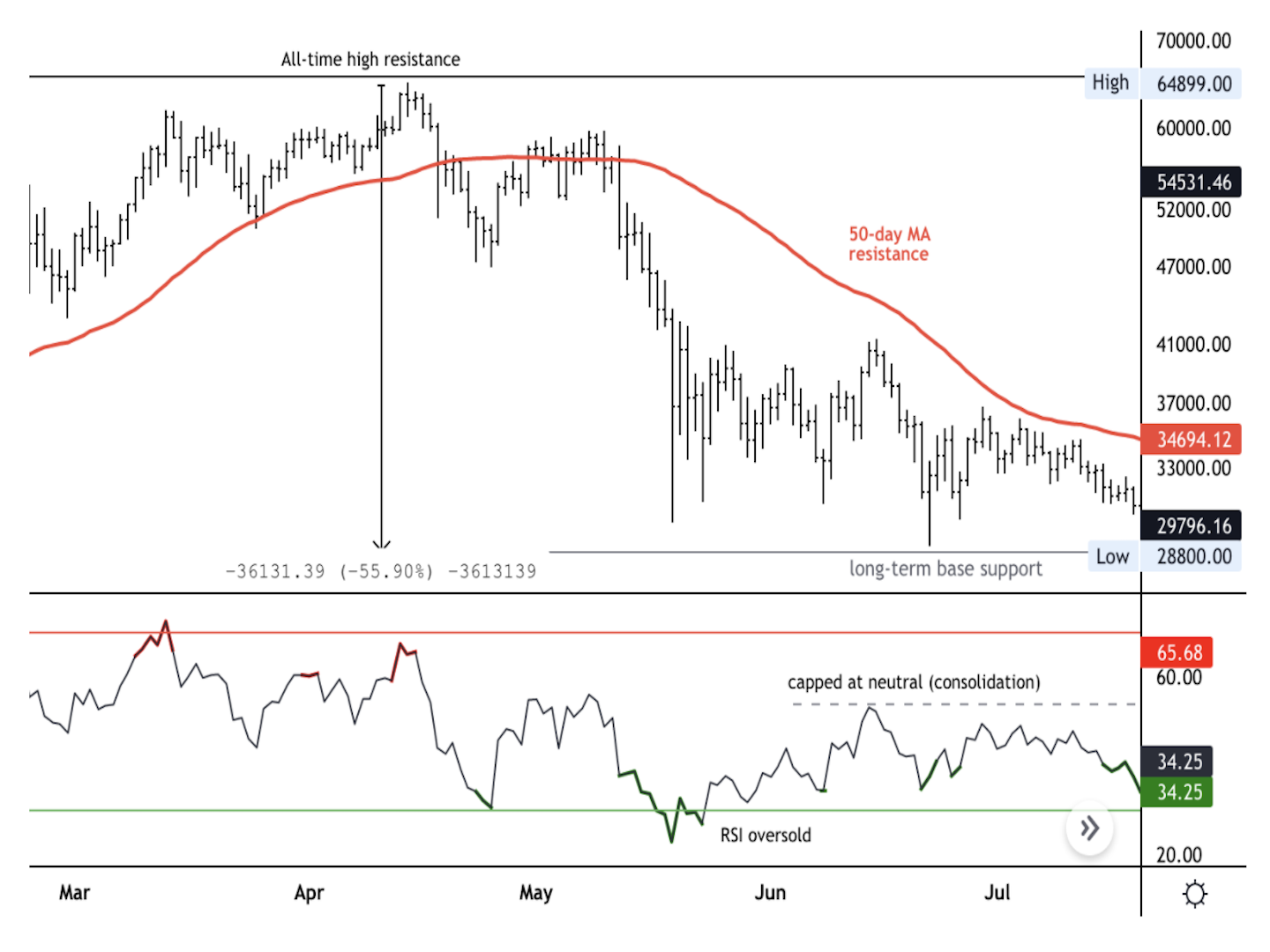The center of the market is still at the expiry of the options contract on Dec. 31.
Good morning. Here’s what’s happening:
Market moves: Bitcoin trades near $48,000, while layer 1 token ALGO gains on incentive program news
Technician’s take (Editor’s note): Technician’s Take is taking a hiatus for the holidays. In its place, First Mover Asia is publishing a piece from CoinDesk reporter Damanick Dantes’ Year-End Review series, which recaps this year’s most dramatic moments in cryptocurrency markets.
Prices
Bitcoin (BTC): $47,394 -0.3%
Ether (ETH): $3,742 -1.66%
Markets
S&P 500: 4,793 +0.14%
DJIA: 36,488 +0.25%
Nasdaq: 15,766 -0.98%
Gold: $1,803 -0.15%
Market moves
Bitcoin continued to fall, trading near $47,000 on Wednesday, after a sharp drop by more than 6% a day ago.
The No.1 cryptocurrency by market capitalization had another low daily volume across centralized exchanges due to the year-end holiday season. The center of the market is still at the expiry of the options contract on Dec. 31.
Credit: CoinDesk/CryptoCompare
A total of 124,700 option contracts worth nearly $6 billion are set to expire on Friday, according to data provided by Skew. Options are hedging instruments that give the purchaser the right but not the obligation to buy the underlying asset at a predetermined price on or before a specific date.
At the same time, smart contract platform tokens algorand (ALGO) and near (NEAR) led the biggest daily gains during U.S. trading hours on Wednesday. ALGO’s gains came after Algorand Foundation announced a liquidity incentive program with Algorand’s first algorithmic money market and stablecoin protocol Algofi.
Year-end market wrap
Market Wrap Year-End Review: Institutions Cash Out of Bitcoin: One big investment firm pocketed big profits by selling bitcoin near the market top in April before the price tumbled.
Hello, Market Wrap readers! During the final two weeks of 2021, we’re using this space to recap this year’s most dramatic moments in cryptocurrency markets – and highlight the key lessons from this fast-evolving corner of global finance. Over a series of eight posts starting on Dec. 20 and running through Dec. 30, we’ll recap what shook crypto markets this year. (If you’re looking for today’s prices and news headlines, please scroll down.)
In a recent episode of this year-in-review series, we recapped the onslaught of fear, uncertainty and doubt – “FUD,” in crypto-speak, meaning really any negative headlines – that shook crypto markets in April and May. Mood dampeners included the threat of higher U.S. capital gains taxes, China’s reinvigorated efforts to stamp out cryptocurrency trading and mining and the potential environmental harms from the Bitcoin blockchain’s extensive electricity usage.
Today, we’ll show additional reasons for widespread selling that occurred in April and May. After bitcoin’s powerful rally to start the year, fueled by fear of fast inflation, some large investors grew concerned about rampant speculation in the almost-anything-goes market and a slowdown in global money supply growth. In fact, some price chart indicators were already suggesting that bitcoin was overvalued. By June, BTC had stabilized at around $30,000, and guess what happened then? Traders bought the dip.
Funds cash out
Ruffer Investments, a U.K-based asset management company, was one of the earliest big institutional investors to bet on bitcoin – starting in November 2020.
As prices shot up during early 2021, Ruffer essentially rode the wave while other fund managers were just warming up to crypto, lured by its potential for high returns.
“Last November we gained exposure to bitcoin. We viewed it as an option on an emerging store of value with a highly skewed and attractive risk/reward profile,” Duncan MacInnes, investment director at Ruffer Investments, wrote in a blog post on July 9.
But even Ruffer was taken aback by the ferocity of bitcoin’s price rally at the start the year to a new all-time high of around $65,000. And Ruffer cashed out. The market seemed to be unsustainable.
“In 2021, the excitement is in cryptocurrencies and decentralized finance. The promise is real. But so, too, is the surge in excess liquidity generated by fiscal stimulus and ongoing quantitative easing. Excess liquidity looked to us to be peaking in April,” MacInnes wrote.
The Sunday Times reported in June that Ruffer made a $1.1 billion profit in five months.
Bitcoin price and global money supply
Extreme bullish sentiment
In terms of the market reversal, it sure didn’t help that several crypto-market indicators were flashing signs of excessive buying activity in the month or so leading up to bitcoin’s April price peak. For example, around March, Alternative.me’s Crypto Fear & Greed Index reached the highest level since June 2019, which had preceded a nearly 60% BTC price sell-off.
There were other warning signs in both blockchain data and price charts. (See the chart below, which looks at technical indicators on bitcoin’s “market value to realized value” ratio, a blockchain-based market metric known as MVRV.)
Crypto industry responds to ESG concerns
As nagging environmental concerns over bitcoin’s environmental footprint continued to weigh on the market, crypto-industry executives took steps to respond.
Elon Musk – the billionaire Tesla CEO whose market-moving tweets earlier in the year revealed an on-again, off-again infatuation with bitcoin – sounded a fresh openness to crypto industry dialogue over the Bitcoin blockchain’s electricity usage. Toward the end of May, Musk tweeted that he spoke with bitcoin miners about using renewable energy resources. He wasn’t turning his back on bitcoin completely, which provided some hope for discouraged bulls.
Spoke with North American Bitcoin miners. They committed to publish current & planned renewable usage & to ask miners WW to do so. Potentially promising.
— Elon Musk (@elonmusk) May 24, 2021
The announcement on May 24 of the Bitcoin Mining Council, which banded together miners and large investors, including MicroStrategy CEO Michael Saylor, sent BTC immediately higher by almost 12%. At that point, market panic from the April sell-off began to fade, and some traders began to buy the dip.
BTC’s price eventually stabilized at about $30,000 in June as extreme selling pressure began to slow. The chart below shows the nearly 50% price drop between April and June. And then, over the course of July and August, bitcoin mostly traded sideways, establishing a new price range as some technical indicators suggested BTC’s price was oversold.
The question in the minds of crypto traders was whether the new market environment represented a pause on the way down or the foundation for a fresh leg up.
Bitcoin daily price chart
Price movements were far less volatile than they had been in recent months, and it seemed as though many investors still believed in bitcoin’s potential as a long-term store of value. Bitcoin miners claimed to be looking for ways to reduce or mitigate their environmental footprint, and most of the network’s mining power relocated away from crypto-unfriendly China.
Plus, traders weren’t using as much leverage, and market conditions seemed to calm markedly. In other words, there wasn’t much froth.
A key takeaway was that, despite what suddenly seemed to an unrelenting onslaught of negative headlines for the bitcoin market, the price was holding up remarkably well on a historical basis: The April all-time high of around $65,000 was now looking far away, but so was the 2020 low of around $3,850.
Speculation was still running high in other areas of the crypto market. In the next episode, we’ll show how some traders flocked to alternative cryptocurrencies and non-fungible tokens (NFT) while bitcoin traded sideways.
Important events
5 p.m. HGT/SGT (9 a.m. UTC): European Central Bank M3 money supply (3 mos./YoY/Nov.)
5 p.m. HGT/SGT (9 a.m. UTC): European Central Bank private loans (Nov./YoY)
9:30 p.m. HGT/SGT (1:30 p.m. UTC) U.S. goods trade balance preliminary (Nov.)
11 p.m. HGT/SGT (3 p.m. UTC): U.S. pending home sales (MoM/YoY Nov.)
All writers’ opinions are their own and do not constitute financial advice in any way whatsoever. Nothing published by CoinDesk constitutes an investment recommendation, nor should any data or Content published by CoinDesk be relied upon for any investment activities. CoinDesk strongly recommends that you perform your own independent research and/or speak with a qualified investment professional before making any financial decisions.
Recommended Content
Editors’ Picks

Dogecoin and Bitcoin Cash Price Prediction: Funding rates decrease indicate weakness in DOGE and BCH
Dogecoin and Bitcoin Cash registered 3% and 8% losses on Tuesday following increased selling pressure from the futures market. The decline comes amid large-cap cryptos like Bitcoin, Ether and XRP, holding still with slight gains.

XRP could sustain rally amid growing ETF and SEC vote prospects
Ripple flaunted a bullish outlook, trading at $2.1505 on Tuesday. Investor risk appetite has continued to grow since the middle of last week, propping XRP for a sustainable upward move triggered by the swift decision by US President Donald Trump to suspend reciprocal tariffs for 90 days.

VeChain Price Forecast: VET bulls aim for a double-digit rally
VeChain price hovers around $0.023 on Tuesday after breaking above a falling wedge pattern the previous day; a breakout of this pattern favors the bulls. Bybit announced on Monday that VET would be listed on its exchange. Moreover, the technical outlook suggests rallying ahead, targeting double-digit gains.

Dogecoin, Shiba Inu and Fartcoin price prediction if Bitcoin crosses $100K this week
The meme coin market fell sharply on Monday, shedding 4.8% in market capitalization to settle at $49.25 billion, according to data compiled from CoinGecko. The sell-off coincided with increased volatility across broader crypto markets while investors rotated funds into Bitcoin briefly tested $85,000.

Bitcoin Weekly Forecast: Market uncertainty lingers, Trump’s 90-day tariff pause sparks modest recovery
Bitcoin (BTC) price extends recovery to around $82,500 on Friday after dumping to a new year-to-date low of $74,508 to start the week. Market uncertainty remains high, leading to a massive shakeout, with total liquidations hitting $2.18 billion across crypto markets.

The Best brokers to trade EUR/USD
SPONSORED Discover the top brokers for trading EUR/USD in 2025. Our list features brokers with competitive spreads, fast execution, and powerful platforms. Whether you're a beginner or an expert, find the right partner to navigate the dynamic Forex market.



